
 |
|
|
Colors of The Tennessee
Walking Horse |
|
 |
|
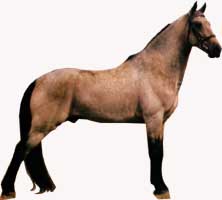
|
BUCKSKIN |
|
A diluted bay coat mixture of red and
black hairs from a bay coat results in several shades of the
buckskin horse with a black mane and tail. The actual shade of the
diluted coat depends upon the degree of black hairs intermingled
with red hairs. The dark bay, for example, is diluted to a sooty
yellow with black points. There are many shades of diluted bay
coats, from off-white to sooty tan. The most common color for the
buckskin is a tan. |
|
|
 |
|
DUN |

|
| Closely
related to the buckskin, the dun horse is usually flashier in color,
and with frequent dark dorsal stripes and zebra" stripes on the
shoulders and legs. The dun body coat is also a dilution of the
bright red bay to a clear yellow with dark points. |
|
|
 |
|
CHESTNUT |
|
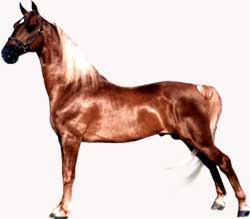 |
|
The copper-colored chestnuts vary in
shade from a light golden red to a dark reddish brown, sometimes
identified as a "liver chestnut." Quite often, the mane
and tail will be the same color as the body but, occasionally, a
chestnut will have a flaxen mane and tail, and will often show white
face and leg markings. Light blonde baby fuzz on their legs
should not be confused with true white markings, with the hairs
springing from a pink skin. Genetics dictate that the mating
of two chestnuts always results in a chestnut foal. |
|
|
 |
|
CREMELLO |
|
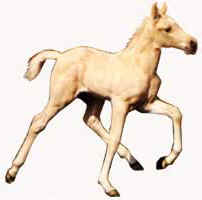 |
The base color of the
body is nearly white but with a yellow tinge. Mane and tail
color ranges from white to muddy yellow. Other "white" horses
may be derivations of aging greys (in rare occurrences); the
roaning horse also carrying grey genes. |
|
Another possibility
for the "white" horse is the "dominant white." This term
is used to describe a horse that is born completely white, with pink
skin and colored eyes (blue, brown, amber, or hazel). A
dominant white horse is truly white, not cream-colored like the
cremello (pseudo-albino). True albinos (pink skin, pink eyes
and completely white coat) are unknown among horses and should not
be confused with 'pseudo-albino cremellos (pink skin, blue
eyes and almost-white coat.) |
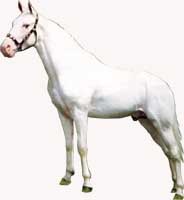 |
|
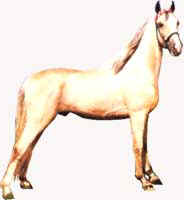 |
Another near-white
horse is the perlino, whose lack of color is attributed to a
dilution of the bay ancestry. The coat is diluted to near white
while the dark points either remain dark or become a light rusty or
chocolate shade. The perlino pattern also may be marked by a dark
dorsal stripe and sometimes zebra marks on the legs and shoulders. |
|
|
 |
|
OVERO |
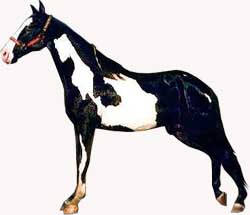 |
|
White spotting of the overo horse
usually comes up from the belly and rarely across the back. The
white areas are usually irregular with uneven edges. The overo horse
may have solid-colored legs, except for normal white markings. Overo
spotting can occur on any color base background. It may also have a
white bonnet that covers the ears and poll and encircles the neck at
the throat; it may be bald-faced, covering both eyes, or
apron-faced, with white markings extending beyond the ears and under
the chin. The eyes of an overo with extensively white facial
markings are frequently blue or white ("china eyes"). |
|
|
 |
|
SABINO |
|
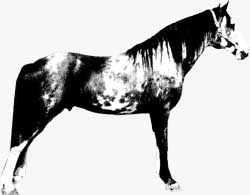 |
The sabino is a horse
with color and markings similar to the roan, yet it is genetically
different. Its base coat color is mixed with white hairs, similar to
roaning, but often with overo markings: high stockings, white face,
white spots. The base color, bay, black, chestnut, etc. is used with
sabino for better identification: i.e. "bay sabino", "chestnut
sabino", etc. |
|
|
 |
|
TOBIANO |
| A tobiano TWH is
basically solid-colored, spotted, and with four white legs. The face
is marked similarly to that of a solid horse with a dark head and
white face markings such as a star or strip. |
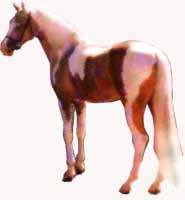 |
|
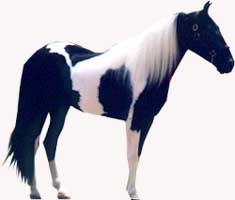 |
The tobiano has white
spots that are regular and rounded, with even borders, and cross
over the back. |
| The base color can be
any color recognized by TWHBEA (black, bay, chestnut, sorrel,
palomino, buckskin, etc.; the white spotting occurs with all colors
except dominant white.) |
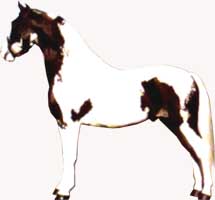 |
|
|
RESEARCH: DR. DAVE WHITAKER
|
|
PREVIOUS
COLORS |
|
 |
|
|
|
|












